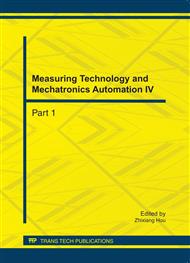p.301
p.307
p.314
p.318
p.323
p.329
p.333
p.338
p.343
Study on Electromagnetic Exciting Force Characteristics and Electromagnetic Noise of Permanent Magnet DC Motor
Abstract:
Electromagnetic exciting force is the key to generate electromagnetic noise. The characteristics of electromagnetic exciting force and the causing of electromagnetic noise were analyzed after the power was off for cooling fan Permanent Magnet DC (PMDC) motor. Time-stepping finite element method was selected to calculate its several parameters, such as air gap magnetic density harmonics generated by the stator and rotor, torque ripple and unbalanced magnetic pull at its different speed.Experiment on unloading vibration noise was carried out to confirm the validity of electromagnetic exciting force analysis. The results show: electromagnetic force amplitude keeps constant while the motor speed changing. Torque ripple decreases while the motor speed down. A kind of electromagnetic noise called howling noise produced by PMDC motor used in car cooling fan is mainly due to resonance. So the best way to eliminate this motor’s noise is to improve the order of electromagnetic waves and avoid the electromagnetic resonance.
Info:
Periodical:
Pages:
323-328
Citation:
Online since:
October 2011
Authors:
Price:
Сopyright:
© 2012 Trans Tech Publications Ltd. All Rights Reserved
Share:
Citation:


